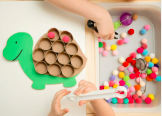Introducing math to preschoolers doesn’t have to be about worksheets or memorization. At this early stage, children learn best through hands-on experiences, engaging play, and exploration. By using creative methods, parents and educators can help young learners develop foundational math skills in ways that are both effective and fun.
1. Turn Everyday Moments into Math Opportunities
Math is all around us, and daily routines offer plenty of chances to teach counting, sorting, and patterns. Whether it’s setting the table with the right number of utensils or counting stairs while walking, these simple moments naturally build number awareness.
2. Use Manipulatives for Hands-On Learning
Objects like blocks, buttons, or colored beads help preschoolers understand numbers, shapes, and measurements through touch and movement. Sorting these items by color, size, or shape builds early problem-solving skills while keeping kids actively engaged.
3. Incorporate Music and Movement
Songs with counting or rhythm patterns make math memorable and joyful. Dancing to songs that include number sequences or following movement instructions based on math concepts (like jumping three times or clapping five times) adds a kinesthetic layer to learning.
4. Explore Math Through Stories and Picture Books
Storybooks that include counting, sequencing, or shapes can bring math to life in an enjoyable and relatable way. Books encourage children to visualize numbers and patterns while enhancing language and comprehension skills.
5. Create Math Games and Challenges
Simple games like matching number cards, rolling dice and counting, or playing “find the shape” scavenger hunts introduce math through play. These activities foster a love for learning while subtly reinforcing important skills.
6. Make Use of Art and Crafts
Crafts offer a colorful way to practice counting, patterns, and measurements. Creating shape collages, bead patterns, or number-themed drawings encourages both creativity and mathematical thinking.
7. Bake and Cook Together
Kitchen activities naturally involve measuring, comparing quantities, and following step-by-step instructions. Counting ingredients or using measuring cups is a tasty way to reinforce numbers and fractions in a real-world setting.
8. Use Technology Thoughtfully
There are many age-appropriate educational apps and games that focus on early math concepts. Used in moderation and with guidance, digital tools can support and reinforce what children learn through hands-on play.
Conclusion
Teaching math to preschoolers is about more than just numbers — it’s about nurturing curiosity, encouraging exploration, and building confidence. By incorporating creativity into everyday moments and activities, educators and families can help children develop a strong and positive relationship with math from the very beginning.














